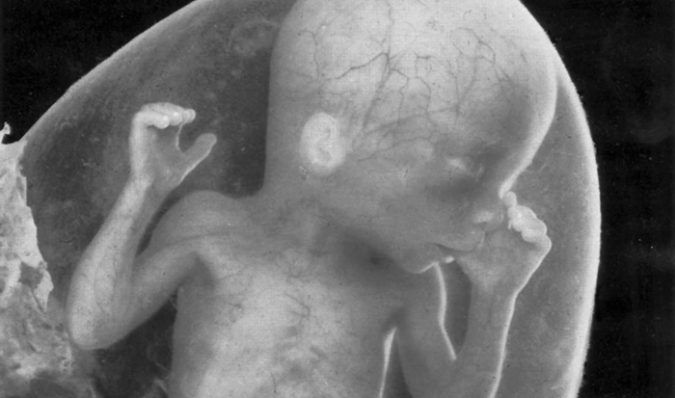You’re going to see the heart beating – little hearts, you know – and then, all of a sudden, you’re going to put this cardiac medicine in it to make it stop – to kill it.
When pro-lifers show pictures of aborted babies or talk about how preborn children are torn apart in abortions, many people don’t want to believe them. They claim that the pictures are fake, and that the stories of mutilated babies are false or exaggerated. But when abortion facility workers themselves describe abortion’s brutal aftermath, it is harder for people to dismiss.
Pro-choice feminist Wendy Simonds wrote an unabashedly pro-abortion book titled, “Abortion at Work: Ideology and Practice in a Feminist Clinic.” In the book, facility worker “Carrie” freely uses the term “baby” to describe the children she helps abort:
At nine weeks… you start seeing fetal parts. [Ellipses in original] And by the second trimester, it’s, you know, it’s a baby, and by the eighteenth week it’s definitely a baby. And by, like, you know, twenty-two weeks you go in and you watch someone do a sonogram, and you’re like, “Oh my.” There it is just moving, moving around. And it’s really, really hard because I always thought of abortion in terms of just the woman, just her body… And I never even allowed myself to think, you know, isn’t it a shame that there’s something alive inside her that’s not going to be alive anymore if she has an abortion. (81)
One abortion worker describes seeing preborn babies on ultrasound:
[N]ow you can see that it’s a fetus and it looks like a baby, and it sucks his thumb, and it, you know kicks around, just like newborns do. (page 79)

Another worker describes witnessing an abortionist inject the drug digoxin into the hearts of preborn babies to kill them:
It’s going to be weird now because you’re going to see the sono. You’re going to see the heart beating – little hearts, you know – and then, all of a sudden, you’re going to put this cardiac medicine in it to make it stop – to kill it. I won’t kill it, the doctor will kill it…. It’s just a harder reality check of what we’re doing…. It’s like rationally I know this is going to be much better because, God, you know, if it can make a twenty-three-week skull come out easier, you know bless this digoxin. (73)
Although she reiterates that it’s the doctor and not she who is killing the baby, her words show a certain amount of ambivalence about witnessing the killings first hand. However, she “thanks God” for the poison that makes babies easier to abort, showing that her ambivalence goes only so far. She is dedicated to killing these children.
Clinic worker “Nell” describes why it is hard for her to see what’s left over after abortions:
Because it looks like a baby. That’s what it looks like to me. You’ve never seen anything else that looks like that. The only other thing you’ve ever seen is a baby…. You can see a face and hands and ears and eyes and, you know… feet and toes…. It bothered me really bad the first time…. (88)
Clinic worker “Sarina” describes the following:
Features are discernible, you can count five fingers on a hand, and five toes on a foot. You know, all the organ systems are formed. You know, you can see ears as structures, and the nose and eyes as structures…. I think the destruction is hard. (96-97)
Sarina describes abortion as “destruction” but does not take the next logical step and admit it’s also murder.
Another abortion facility worker describes witnessing an abortion at 21 weeks, standing at the feet of the mother while the abortionist took the baby apart piece by piece:
You’re looking between the woman’s legs; you’re seeing, you know, what the doctor’s doing. And it’s what a lot of people would call kind of, I guess, gruesome… it’s identifiable. I mean, when he… takes the forceps and pulls out a foot, you can see the foot, and my reaction – because I feel so strongly that women who want to have a 21 week abortion should be able to have that – but I mean when I looked and was just like, you know my first reaction was you know, I was pretty horrified. And I immediately denied that, and I said, you know, “no, that can’t be my reaction. I’m here for the woman,” and just really sort of squashed that down, that what I saw really freaked me out. And it stayed with me, you know, and really upset me. I mean, I’d be in the shower, you know, washing my feet, you know, and… The picture would come to me… I got to the point where… I just really needed to sit down and cry, and, like, deal with it. (82)
Many people believe that every human being has a conscience, a basic underlying knowledge of right and wrong. This abortion worker has stifled her conscience, forcing herself to focus only on the woman and not on the baby being aborted. Perhaps if she knew how harmful abortion was to women, raising the risk of suicide, leading to potential premature births of future wanted children, increasing the risk of breast cancer, and otherwise damaging their mental and physical health, she would feel differently.
It is safe to say that Simonds has no pro-life bias.
Yet she does explore the feelings of ambivalence abortion facility workers have when they handle the remains of aborted babies. The abortion facility Simonds writes about commits abortions up to 26 weeks, a time when the baby could survive if born. In fact, at 26 weeks, a baby has an 80-percent chance of surviving premature birth.
Abortion worker “Diana” was comfortable, Simonds notes, with handling aborted babies until she saw one with hair:
Sterile room is so fast-paced. And I’m a person who’s really into learning…. And so, okay, now I’ve got the technical down, so now I can, like, get lax in my thought processes. You know, it becomes more robotic. And I think that what happened one day [was] I stepped back inside of myself, and I was just like, “Oh my God, what are you doing? When I saw the hair….” (72)
Whereas abortion worker “Risa” was more hardened, saying only:
I hate it when people put it [the body parts of the aborted fetus] together to look like a baby. I hate that… (86)
Simonds writes that none of the abortion workers would look at the faces of the babies while “processing tissue.” (86-87)
These disturbing quotes lend credence to the idea that the pictures pro-lifers display are accurate representations of abortions. When pro-lifers describe abortion, they are telling the truth, and these pro-choice testimonies are more proof of that.
Throughout the book, abortion workers make many nasty remarks about pro-lifers. One says:
Is there an honest way to be antiabortion?… To me, no, there’s not. It’s like, is there an honest way to be anti-Semitic? Is there an honest way to be racist? There’s not. And, to me, abortion is one of those fundamental things in the same league. (111)
Another:
My gut feeling is: I hate [pro-lifers]. I want them to die! But realistically, I mean, I’ve come to the point where if I can’t deal with it, it’s like I want to yell at them and hit them over the head with a [f——] Bible and go, “you’re stupid! You don’t know what you’re talking about!” (119)
And another:
The feeling of violation, of [their] violating my space, of them filthying my space… with their presence!… I mean, I realized that I could kill a human being. I realize that if I got my hands on them, I was gonna rip them apart… I knew I could strangle one of them. I just knew it. (123)
Another makes these ironic comments about pro-lifers who posed as abortion seekers and entered the facility, trying to learn how they treated their patients:
They were out picketing… not too long later, and I thought, they know the truth, I mean, we show them how humane we are in that we’re not, you know “baby killers” – I mean that we were real people, and we’re nice people, and we’re decent, and we’re human. And I just wanted to shoot them. I was just disgusted. [Emphasis mine.] (113)
The workers’ near pathological hatred of pro-lifers may have been a product of their uneasy consciences. The pro-lifers confronted them with the truth about what they were doing, and the workers reacted with violent anger.
Would there have been any way to get past that anger and reach these women? It would take a great deal of patience and tolerance of abuse to get past their angry rationalizations. But deep down, these workers know they are committing violence against innocent human beings.
Reading such graphic descriptions of abortions in such an extremely pro-abortion book makes it hard to dismiss what pro-lifers say happens behind the closed doors of abortion facilities. The pro-life accounts are proven true. This is reality, unfiltered and uncensored. The dismembered body parts, the heartbeats visible on sonograms, and the human faces of aborted children are all documented by people as pro-abortion as they come. There is no denying the horror of abortion after reading this book.
Source: Wendy Simonds Abortion at Work: Ideology and Practice in a Feminist Clinic (New Brunswick, New Jersey: Rutgers University Press, 1996)








